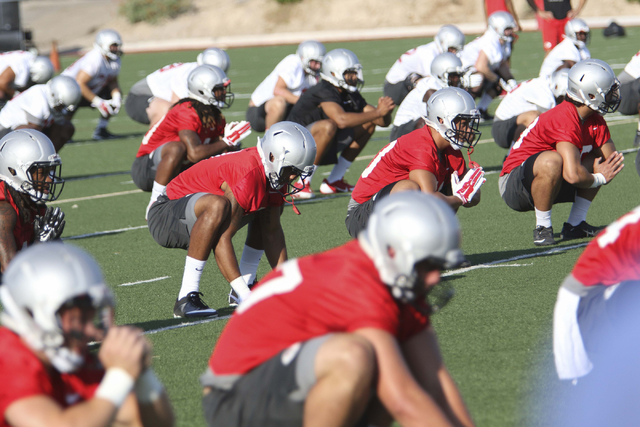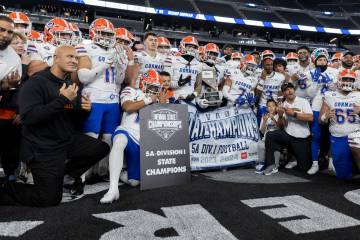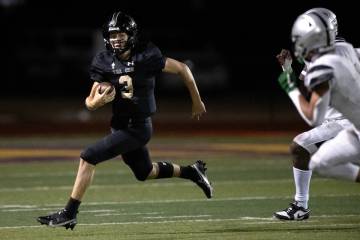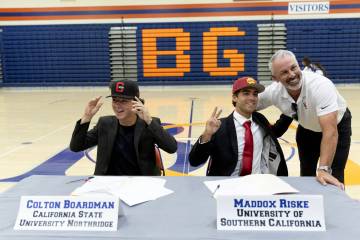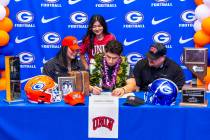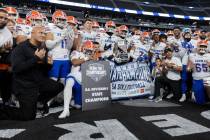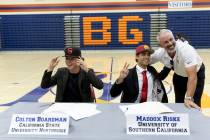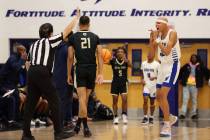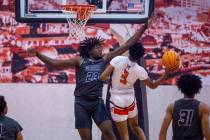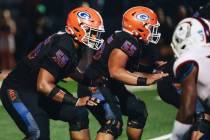Recruiting Game: Schools, athletes juggle the cost of a college scholarship
Parents of high school athletes can spend hundreds or even thousands of dollars each year trying to better the chances of their child getting a college scholarship.
Individual lessons, club or travel teams, newer and better equipment can run up a large tab in a short amount of time.
But the money spent early sometimes leads to a pot of gold at the end of the rainbow.
As tuition, room and board, books, lab fees and other college expenses continue to rise, the gamble becomes increasingly worth it for some, even if the odds are stacked against a high school athlete ever playing in college.
Approximately 460,000 athletes compete at NCAA colleges and universities, with 53 percent receiving at least some financial aid, according to the NCAA. But the NCAA also says only about 1 in 50 high school athletes receives an athletic scholarship of any kind in college.
Nevada’s two Division I universities — UNLV and UNR — offer the NCAA maximum number of scholarships in each sport they field. And a full ride for four years of college is like hitting a jackpot.
“Every program is fully funded,” said UNLV senior associate athletic director Eric Toliver. “It’s not easy.”
There’s no set value for a four-year scholarship across the nation, as tuition, fees and room and board vary from school to school, and out-of-state fees or even international fees increase the costs.
The blood, sweat and tears athletes go through in preparation to play in college and then on a daily basis in conditioning, practices and games do have a price tag, though.
At UNLV, that number is $18,786.60 for an in-state student, at least for the 2016-17 school year.
Course fees make up the largest portion of the total at $6,516.60. Room costs are $5,880. Board, basically meal plans, is another $5,044. Toss in another $800 for books and $546 in mandatory student fees to get to the total.
“It includes everything,” Toliver said. “Nothing comes out of pocket unless there’s something they want to spend.”
Over the course of four years, if there are no increases in any area, a full scholarship would be worth just more than $75,000 for a Nevada resident. For an out-of-state student, the scholarship value includes $13,910 per year in out-of-state tuition fees, bringing the four-year total to more than $130,000.
In addition, the NCAA has allowed schools to tack on a little more money per athlete to pay for other expenses. The NCAA calls it a cost of attendance stipend, and it can include travel to and from school or other expenses such as child care or medical costs.
UNLV athletic director Tina Kunzer-Murphy was hopeful to provide cost of attendance to all scholarship athletes starting with this school year. UNLV offered the cost of attendance stipend to football and men’s and women’s basketball last season at approximately $4,500 per athlete.
Toliver also said UNLV has a “student-athlete opportunity fund.”
“It’s a fund, dollars allocated from the NCAA through the conference to UNLV,” he said. “It’s sometimes up to $200,000 a year that we’re allowed to give to student-athletes for needs. If one of your parents passed away or a sibling is sick, we can pay for your flight home. If you have clothing needs, we can give up to $500 for clothing. We had a student-athlete whose apartment caught fire, lost everything. This fund allows us to replace his computer, his clothes, not all of his clothes, but he could get the things he needed.”
At UNR, the value of a scholarship is similar. For the 2016-17 school year, UNR will charge $7,142 in fees, $5,500 for a room, $5,058 for board and $800 for books, bringing the total for an in-state resident to $18,500. Were all costs the same for four years, a four-year full ride would be worth $74,000.
UNR includes a miscellaneous stipend of $4,800 per athlete per year, bringing the potential total to $23,300 per year or $93,200 for four years.
“The miscellaneous stipend is the terminology we created here at Nevada to additional expenses as the ‘Cost of Attendance’ terminology in the financial aid world describes more than just that amount,” UNR assistant athletic director Ryan Mitchell wrote in an email. “The miscellaneous stipend is available to each sport. Our ‘head count’ and ‘equivalency’ sports will operate a little differently in how they allocate the money, but each has the miscellaneous stipend available to them.”
Out-of-state students at UNR pay an additional $13,910 per year in tuition, so the value of a scholarship to an out-of-state student is more than $37,000 per year.
Head count sports are ones such as football and basketball, in which a school is limited on the number of athletes on the team who can receive an athletic scholarship. For football, that number is 85 for an NCAA Division I school.
Equivalency sports also are limited in the total amount of financial aid they can give out, but that number can be divided among more athletes. A sport such as soccer, which has a limit of 9.9 scholarships but has 11 players on the field and more on the bench, can divide the value of those scholarships by as many athletes as the school or coach sees fit.
“All my equivalency sports, they maneuver their dollars around quite a bit,” Toliver said.
An athlete in an equivalency sport still could get a full ride for all four years, but it’s more likely he or she would get a year or two years paid for and would pay out of pocket for the remainder of his or her career.
“Coaches will say ‘I’m going to give you a scholarship for your freshman and sophomore year, but I’m not going to do it for your junior year because I have some needs. Do you want it on your front end or your back end?’” Toliver said. “Coaches can make a written agreement with a student, and if the student agrees to it, it’s a working document.”
Athletes who are not offered a full scholarship still could get all of their college expenses covered through other types of financial aid.
“We require all of our athletes to fill out their FASFA (free application for federal student aid),” Toliver said. “We also recommend them to apply for academic scholarships. We also have a summer job program that we help student athletes get jobs or internships for the summer.”
Nevada high school students planning to attend either UNLV or UNR can apply for Millennium Scholarships, which helps for the cost of course fees. Nevada high school athletes’ access to financial aid through the Millennium Scholarship or other avenues often makes them more appealing to equivalency sport coaches at UNLV and UNR.
“You look at our men’s soccer program, the majority of those kids are local kids,” Toliver said. “We have a lot of local kids in our baseball program. The Millennium Scholarship isn’t countable toward our aid limit, so coaches will go out and recruit kids that they know are getting financial aid.”
College of Southern Nevada also offers athletic scholarships in baseball and softball. The school is not governed by NCAA scholarship limits and offers 24 scholarships in both baseball and softball.
CSN athletic scholarships cover the costs of tuition and fees and books and supplies, which is listed on the school’s website as $2,522 and $1,040, respectively, for a total of $3,562 per year or $7,124 for two years.
For an out-of-state student, tuition and fees at CSN are $9,167, making the value of a scholarship just more than $10,200 per year.



